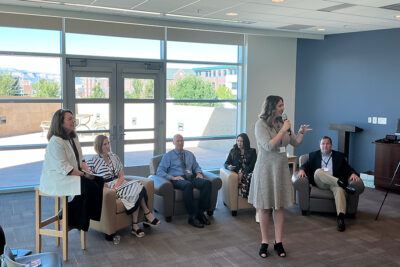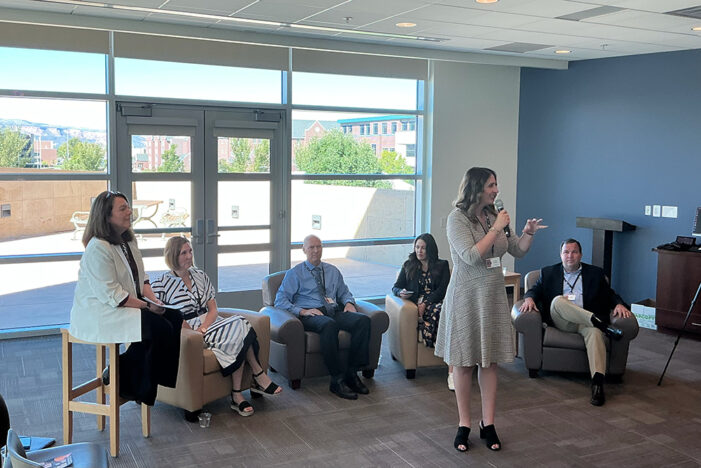Brandon Leuallen, The Business Times

At the Sept. 24 Spark Summit Business and Leadership conference, a breakout session in Room 213 at the Colorado Mesa University Center walked owners through what to do before, during and after a sale of their businesses.
The panel featured high-level brokers and professionals that work with businesses throughout the selling process. The panel included Jeff Elias of SDR Ventures, Suzy Joeckel of EOS Worldwide, CPA Ken Palmer of PBG Advisors, and broker Katie Davis of Bray Commercial Properties, and Carolyn Strauss served as the moderator.
Before the Sale:
Build a company that can be sold
Elias opened the session with advice about thinking the sale all the way through, including what will fill the void when the sale is complete.
“Seventy percent of business owners regret selling in the first year,” he said, noting much of the regret comes from owners not realizing how interwoven the business is into their personal lives.
He urged the business owners to establish a team of experts that surrounds them and knows their goals and values, listing a CPA, wealth manager, estate or real estate attorney, mergers-and-acquisitions attorney, banker, investment bank or business broker, and even a life coach.
“That is what we call a family office,” Elias said.
He stressed early preparation.
“Whether it is one, three, five or 10 years before you sell, you want to build a business that is sellable,” he said.
For firms valued below about $2 million, buyers often look like the current owner. He said businesses above that range attract strategic acquirers, like those that may be buying multiple companies in the same region, and private equity funds come in around $10 million and up. He said fast-growing family offices are common buyers at all levels, investing more in other businesses rather than the stock market.
“Marketing and creating the story around what you created is mission critical,” Elias said
EOS (Entreporeneurial Operating System) implementer Suzy Joeckel compared sale prep to listing a house, and she asked, “Would you put a house on the market without cleaning it and staging it?”
Owners who wait until they are exhausted to sell often lack processes and a developed leadership team. Her top tool is the EOS Accountability Chart, which defines roles, responsibilities and ownership of results. She pairs it with weekly Level 10 meetings and a scorecard.
“Buyers hate surprises,” she said.
Clean financials, documented processes followed by the whole company, and a leadership team running the day to day helped one client sell “in less than six months at a premium,” Joeckel said.
CPA Ken Palmer agreed it is essential to establish policies, processes and teams that can perform without the owner. He said often “too much knowledge lives only in the owner’s head.”
Palmer emphasized clean data. He also encouraged owners to use EBITDA (Earnings Before Interest, Taxes and Amortization) to calculate Seller’s Discretionary Earnings correctly and understand tax basis.
He cautioned against write-offs that backfire when buyers are doing their due diligence. Examples included family members on payroll without real work, and recreational assets on the books.
“Buyers need to feel very comfortable with the figures,” Palmer said.
Katie Davis, a former executive who now brokers deals, said the biggest mistake is simple: “They are not ready.”
She often starts two to three years before going to market. That prep includes separating inventory properly, reinvesting cash in the business rather than pulling it out to minimize taxes, shifting the brand from founder-centric to team-centric, and changing a personal name if the business uses it.
“Choose wisely” when hiring a broker, she added.
During the Sale:
Run a tight and competitive process
Joeckel’s mantra for live deals is consistency. Weekly scorecards on sales, margins, cash and key operating metrics reduce uncertainty for buyers.
Elias helps companies build up to sell at a high price through competition. He described a typical cadence. About two months to craft marketing materials and build a data room. Then indications of interest, letters of intent, and two to three months of diligence to create the closing contest.
“A competitive auction creates a premium,” he said.
Elisas also noted many companies receive unsolicited offers when they aren’t planning to sell, but they can use them as a useful test to ask themselves if they have the company in good enough shape to sell if it came to it.
On finding buyers, Davis said “make sure the business is not on a path to obsolescence. If it is, fix it first or expect a steep discount.” She said some buyers will want to interview staff or bring their own teams, so confidentiality and timing matter.
Palmer urged owners to ask better questions and be willing to pay for good advice.
When to tell employees depends on the situation, as Elias said some firms benefit from open discussion, while others require strict confidentiality until key steps are complete.
Palmer described the spectrum. If the owner is the business, early disclosure can be “catastrophic.” Rather, with strong systems and shared ownership of processes, the team can then help and be an asset in the sale and part of the future of the company moving forward.
After the Sale:
Prevent regret and prepare for the transition
Why do so many owners regret selling? Elias pointed to identity, routine and post-sale expectations.
Many buyers want the seller to stay on.
“Sometimes it is only three or six months, but private equity may want you to roll some proceeds into the new company and stick around for three to five years,” he said.
Owners should decide whether they can work for someone else, and they should make a real plan for life after closing.
Palmer addressed taxes, stressing the need to plan before the deal is signed.
“Allocation and structure matter. Stock versus assets versus personal goodwill can change outcomes and should be negotiated with professionals,” he said
Davis offered a caution on long transitions. If the seller is not aligned with the buyer’s goals, employees will seek the former owner to fix problems.
“Set a goal for what comes next, draw a line for when you are done, and stick to it,” she said.
Joeckel’s final advice was to start now.
“Clean up your financial’s, empower your leadership team, and write your processes,” she said, adding healthier companies sell better and operate better while you still own them.
Strauss closed with a book recommendation for owners considering succession: “Who Comes Next?” by Mary C. Kelly and Meridith Elliott Powell.

